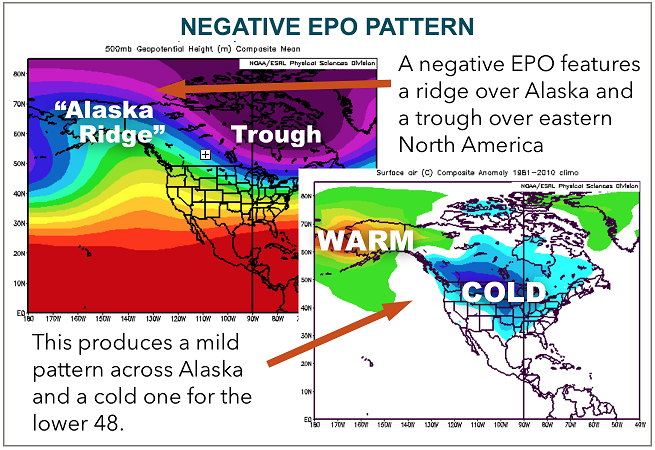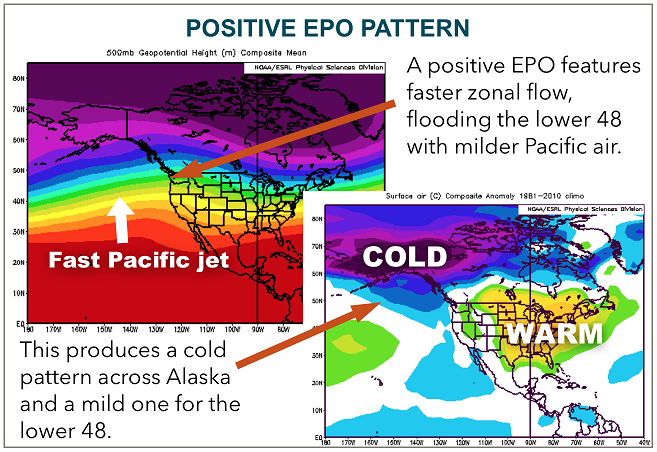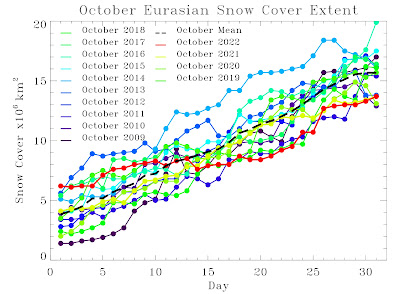After beautiful spells of Indian Summer weather in a delightful but abnormally dry autumn; there's a change in the offing - commencing now, this mid November. Models are progging aggressive cold fronts (of varying degrees) to drive south into much of the country east of Rockies through the upcoming week and at least through the next weekend. The veritable "Summer to Winter" familiar narrative looks appropriate for mid month. Recent record or near record temperatures in the 60s and 70s will fall into the 40s, 30s & 20s.
The projected 500 MB polar projection for November 2022 as of the 9th is below. Both the Polar/Arctic jet and the Pacific jet (Sub Tropical) are displayed for the the remainder of the month and I feel basically; for the winter period.
On to the Winter Outlook...
Temperatures:
Upper Air/Surface Patterns and subsequent chosen La Nina analogues; suggest normal to slightly below normal temperatures or +1.5 to -2.0 of the new 1991-2020 norms. See analogue section for particulars.
Snowfall/Precipitation:
Upper Air/Surface Patterns and subsequent chosen La Nina analogues; suggest normal to locally above the new 1991-2020 norms snowfalls and precipitation. See analogue section for particulars.
Hemispheric Layout
La Nina conditions just keep hanging around in the Pacific. So much so, the Winter of 2022-23 will be the third consecutive La Nina winter to occur since the first in the current set, 2020-21. In the past 130 years, this has only happened four times since the late 1800's. Each three La Nina sets are in the following order with the third La Nina highlighted.
|
SEASON |
|
1892-93 |
|
1893-94 |
|
1894-95 |
|
1908-09 |
|
1909-10 |
|
1910-11 |
|
1973-74 |
|
1974-75 |
|
1975-76 |
|
1998-99 |
| 1999-2000 |
2000-01 |
While La Nina winters have their own set of weather trends across the country; they can vary or be influenced by many other factors, sometimes to the extent they resemble little of the initial La Nina climate/weather standard trends. This is why I feel it is more important to compare "apples to apples rather than bushels to bushels" What do I mean? In my chosen and emphasized analogues; I research the timing, type, and stronger relevance to the up coming La Nina (and in this round; third La Ninas highlighted) rather than all La Nina's in the past century or so. This brings up another relevant point. The majority of La Nina's used in analysis are only since 1950. Why? Because some the data from the later period is based on measured data; especially in water temperature and departures. Instead of trying to explain why I use data at least back 100 years; I'll let the experts explain it. Please read the full article because it is interesting and explains the larger data set which goes back a "century" further to 1854 rather than 1950. The following is excerpts from NOAA Climate.gov "
Exactly the same, but completely different: why we have so many different ways of looking at sea surface temperature
ERSSTv4 goes back to 1854 (although due to a lack of observations in the Pacific Ocean, for El Niño purposes, the dataset reliably goes back to only 1950), and scientists have already put in a lot of time and effort to make this dataset consistent regardless of era (2). So why do we need another one? The easiest answer is that our seasonal climate models don’t run just once a month, but daily. Not surprisingly, they produce better forecasts when they are launched (we say “inititalized”) with a more detailed, more up-to-date view of what the oceans look like at that time.
For this situation, we want as much information as we can get it regardless of the historical consistency. So we rely on a dataset that combines in situ measurements with near-real-time satellite measurements. Satellites are not equipped with magical space thermometers that can measure the ocean temperature directly. Instead, instruments on the satellite detect energy radiating from earth to space. We use algorithms, physics equations and estimations to calculate what the sea surface temperature must have been to generate the amount of energy the satellite detected.
So the next time you want to compare the strength of this El Niño with past historical cases, use the ERSSTv4 dataset, compiled from buckets, boats, and buoys. That is what it was created for. But if you want to see the smaller-scale spatial and more frequent temporal changes of sea surface temperatures that occur within an event, OISST is more useful.
ERSST stands for the Extended Reconstructed Sea Surface Temperature dataset and is updated and maintained by our colleagues at the National Centers for Environmental Information.
La Nina La Nina La Nina
Autumn thus far has contained classic La Nina weather with drier than average fall weather and normal to above temperatures. Plenty of sunshine along with average frost/freeze days rounded off the overall, pleasant weather. Checking the previous La Nina, autumns in our current set of analogues shows the past weather (Temps/Pcpn):
As we move into the winter; a weak to moderate La Nina will prevail across the Pacific and influence the climate and weather patterns over North America.
Late October La Nina SST conditions
Model La Nina Forecast
Types of La Ninas related to placement of colder, below normal Pacific water temps
Thus far the projection for the La Nina is for the coldest departures to be located in the central-eastern Pacific, closer to the resultant seasonal to colder winters (1st and 2nd examples).
Pacific Decadal Oscillation /PDO/ and associated subset EPO
Late October Pacific water temperatures (map 1, above) indicate closest semblance oscillation phase is currently a negative PDO. Note the negative /-PDO/ below on both collection of maps. Generally, a negative PDO coincides with a La Nina (as seen on the negative PDO anomaly pattern map).
Temperatures across Southeast Lower Michigan on the prevailing negative PDO map are normal to slightly above (last map).
Currently; the Pacific Decadal Oscillation is settling into a cool phase and is represented on the right
of the following example; and, compare it to the current state. The cool phase PDO on the right contains a large area of warmer waters extending from Japan east to the mid Northern Pacific. Waters along the Alaskan and Pacific coastline tend to cool somewhat leading to the cool phase.
Warm Phase of the PDO Cool Phase of the PDO
"When SSTs are anomalously cool in the interior North Pacific and warm along the Pacific Coast, and when sea level pressures are below average over the North Pacific, the PDO has a positive value. When the climate anomaly patterns are reversed, with warm SST anomalies in the interior and cool SST anomalies along the North American coast, or above average sea level pressures over the North Pacific, the PDO has a negative value" (Courtesy of Mantua, 1999).
"The Pacific Decadal Oscillation (PDO) is a pattern of Pacific climate variability similar to ENSO in character, but which varies over a much longer time scale. The PDO can remain in the same phase for up to 20 to 30 years, while ENSO cycles typically only last 6 to 18 months. The PDO, like ENSO, consists of a warm and cool phase which alters upper level atmospheric winds. Shifts in the PDO phase can have significant implications for global climate, affecting Pacific and Atlantic hurricane activity, droughts and flooding around the Pacific basin, the productivity of marine ecosystems, and global land temperature patterns. Experts also believe the PDO can intensify or diminish the impacts of ENSO according to its phase. If both ENSO and the PDO are in the same phase (as in this and last Winter of 2021-22), it is believed that El Niño/La Nina impacts may be magnified. Conversely, if ENSO and the PDO are out of phase, it has been proposed that they may offset one another, preventing "true" ENSO impacts from occurring".
http://www.john-daly.com/theodor/pdotrend.htm
Two years back, during the Winter of 2020-21 and our first La Nina of the current three, water temperatures of the La Nina and PDO were out of phase. As it turned out; the winter was indeed notably warmer than what is generally seen in a La Nina winter. This possibility was mentioned in the write-up of the Winter Outlook 2020-21 and one of the reasons noted that may interfere with the normal LA Nina winter jet and temperature pattern.
The evolving cold phase of the PDO this fall and weak La Nina are displayed well in this recent Global SST scan on October 29th, 2022, below.
Eastern Pacific Oscillation /EPO/
North Atlantic Oscillation/Arctic Oscillation - NAO/AO
As usual; this should be one of the most important meteorological influences for this winter. In the last few years, it's had an on and off again effect on our weather, working with Stratospheric warming (delivering cold air to the surface) and the EPO. Refreshing our memory on this little number shows why it is the major influence with our weather.
Generally when the NAO/AO index is in the positive phase; more
zonal winds dominate as the polar vortex lifts up toward or over it's
home, the North Pole region. However; when in a negative phase; the cold
vortex or wind flow is more meridional
and thus; cold Polar or Arctic air is readily pushed south from the
Pole; down into the eastern half of the U.S. (among other Northern
Hemisphere areas). Many times ridges of higher pressure develop in
conjunction on the North American west coast and/or into Greenland.
Siberia/Eurasia /North America Snow Cover
The snow-cover over Siberia has actually been less than average until right at the end of October when it became slightly above normal. The first week of November was above normal.
From recent Dr Jonah Cohen
As can be seen from Figure i, the SCE was relatively
low the entire second half of the month. But please keep in mind of all
the years shown in the plot, only 2011 was below normal so, 2022 is low
relative to recent years but high compared to the long-term average.
And I have been estimating over the past month, the final number will
still likely come in slightly above normal due to the fast start to the
month.
Quasi-Biennial Oscillation /QBO/
THE QBO INFLUENCE
Finally, a new kid on the block in my write-up; see the video from the Met Office in England (click on "What is the Atlantic Multidecadal (AMO). I've known about the AMO since I started my outlooks but since the effects are mainly east especially in the Winter Outlook, I left out of my discussions. Like all Oscillations; the AMO does occasionally affect the Great Lakes.
What is the Atlantic Multidecadal Oscillation (AMO)?
SOLAR CYCLE /SC/
Solar cycle actual effects on short term weather and longer term climate variability remain a controversial subject. I've read several articles which support or are against their shorter term winter relevancy. Some theorize that both natural solar cycles and man's influence affect our climate. I am in favor of the solar cycle being somewhat relevant and sometimes giving the present winter cycle a "little kick" in regard to hemispheric wind flow patterns and resulting temperatures. Numerous recent studies for example, do in fact make the connection to our climate and solar activity including wintertime effects. One of the studies stated the following:
Sirocko et al. (2012) recently reached the same con-
Analogue Sunspots
When reviewing the analogues; I look at where in the solar cycle the sun was in past relevant years and compare them to current sunspot cycle. Since this set of analogues are grouped with La Nina three year periods, the solar X's on the chart are averaged in the three year period.
Ironically; all of the analogue solar cycles during the three year La Nina cycles are at similar strengths as this La Nina years. The all averaged around 100 like this current set of three La Nina's. This three year cycle also averaged from around 75 to 130. Two solar cycles were on the way up and two were on the way down on the analogues. This current set of La Nina's solar cycle is positioned on the way up - like 1892-95 and 1998-2001. As far as the entire weaker solar wave; 1892-95, 1908-11 and 1973-76 are all similar.
Winter 2022-23 Analogues
Temperature, precipitation and snowfall are limited, scant or obviously missing in Flint and Saginaw and those years were excluded from averages. The columns contain a M (no data) and are shaded light purple on the chart. The questionable data is entered but shaded darker purple and again, not included in calculations and averaged.
Analogue La Nina Winters - Temperatures
Analogue Third La Nina Winter - Temperatures
Analogue La Nina Winters - Precipitation/Snowfall
Analogue Third La Nina Winter - Precipitation/Snowfall
Analogue Findings
Late Autumn-Early Winter
If anything; the data shows quite
variable temperatures (a.k.a. roller-coaster pattern) especially month
to month or intra-month. However; one of the first things you notice is that many analogues are "front-end loaded" this time around. Aggressive cold snaps followed by moderation; some with notable snows in November and December. At this early junction; 1975-76 winter stands out at this time as being a potential "predictive analogue" for the winter - given some hemispheric/local similarities thus far. But it is way to early for any "season projection'' and why we must look at all trends and patterns in the analogues.
The last 5 Decembers have been on the mild to warm side for December; I can't vouch for this one but the analogues do suggest this December; colder than average and snowy. Out of all the analogues /12/; eight Decembers averaged below normal while seven had above normal snow. As mentioned above; this would be quite a contrast to the the past several December's temperatures. Of course; patterns usually don't fit neatly into a monthly time-table. Generally the first half of the winter, December - January seemed to be the most notable.
Mid - Late Winter - Early Spring
Mid winter on is more variable; with the entire winter temperatures averaging normal to below. With the warmer climate as of late; it also is prudent to keep that in mind as the norms have risen. While snowfalls are variable; there is a drop-off mid or late winter but with a risk of a late season storm or two. Analogues do intimate the heaviest snow for the 2022-23 season to be over central and northern areas of Southeast Lower Michigan. Basically; roughly northwest of a line from the Ann Arbor area to Port Huron (or a more typical snow layout). We shall see.
Temperatures:
Upper Air/Surface Patterns and subsequent chosen La Nina analogues; suggest normal to slightly below normal or +1.5 to -2.0 of the new 1991-2020 norms.
Snowfall/Precipitation:
Upper Air/Surface Patterns and subsequent chosen La Nina analogues; suggest normal to locally above of the new 1991-2020 norms snowfalls and precipitation.
All Analogue La Nina 500mb Anomalies/Storm Tracks
Analogue Third La Nina 500mb Anomalies
Next we'll take a look at the Computer Guidance around the world for this upcoming winter
Making weather fun while we all
learn,
Bill Deedler
- SEMI_WeatherHistorian



























